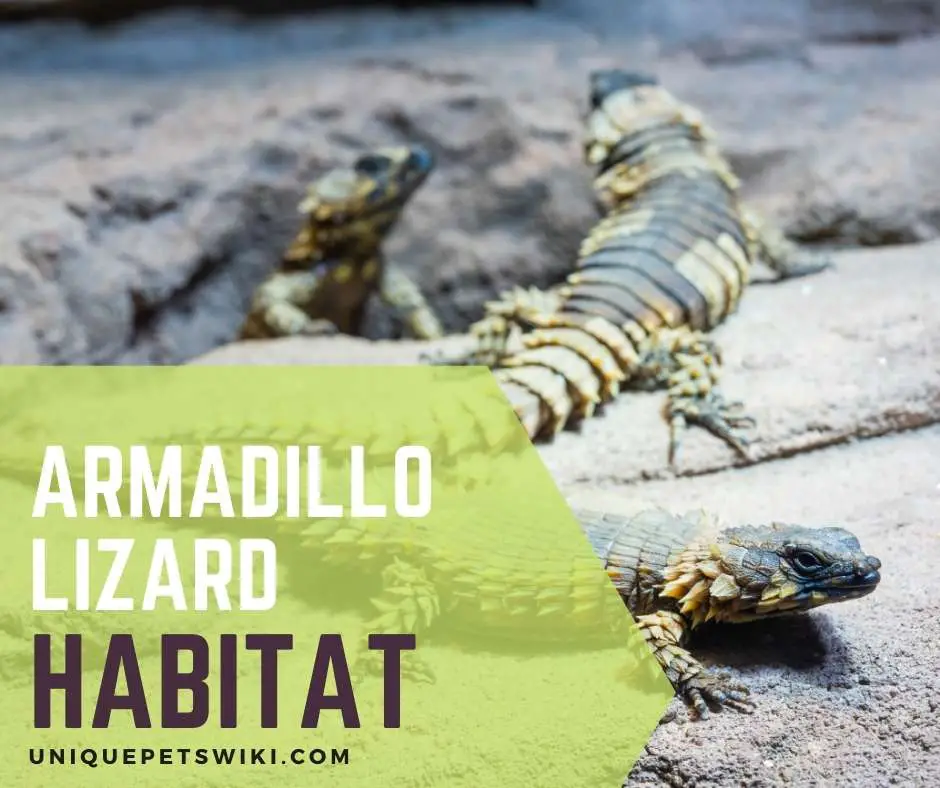Armadillo lizards are also called the armadillo girdled lizards and are usually found along South Africa’s west coast.
Furthermore, their tail length is usually the same or more than their body length.
This helps them to easily coil up by biting their tails to protect against predators.
Armadillo lizards are unique and fascinating reptiles that you can keep at home. They have a spiny armor that resembles a dragon and can curl up to protect themselves from predators.
As a responsible pet owner, you need to know everything about the armadillo lizard habitat before getting one.
In this article, we will highlight everything that you need to know about the armadillo lizard habitat, from the ideal tank to suitable temperature for optimal growth.
Contents
- Armadillo Lizard Habitat
- Armadillo Lizard Tank Size
- Armadillo Lizard Temperature
- Water And Humidity
- Armadillo Lizard Lighting
- Armadillo Lizard Substrate (Flooring)
- Dishes And Bowls
- Basking Accessories Like Branches, Rocks, And Hidey-Holes
- What It’s Like To Own Armadillo Lizard
- Cleaning Their Habitat
- Wrapping Up
Armadillo Lizard Habitat
Armadillo lizards are usually found in rocky outcrops close to termite mounds.

They live in rock crevices and bask in the sun in the day. You will need to provide a captive environment that will mimic their natural environment to keep them happy.
This means you need to set up a habitat with high temperature, plenty of rocks, and low humidity. You will need to include lots of flat rocks for your armadillo lizard where they can lie on or under it.
Armadillo Lizard Tank Size & Set Up
- Tank Type: glass or plexiglass.
- Tank Size: 30-gallon.
- Lighting: fluorescent.
- Substrate: reptile carpet.
Armadillos lizards are social animals, and you can house them together. You can easily keep about two armadillo lizards comfortably in a 30-gallon tank.
Armadillos lizards love climbing rocks but cannot climb on glass walls.
This means you don’t need a lid or the top of the tank’s wall is high enough. Your armadillo lizard needs lighting to help ensure that they get enough vitamin D.
Armadillo Lizard Tank Size
The ideal tank size for one or two armadillo lizards is a 20-gallon tank. However, if you have more than two lizards, you will need to increase their tank size to accommodate the additional lizard. Furthermore, they will need places in the tank where they can climb like rocks, branches, tree bark, and hideaways.
Armadillo lizard’s natural habitat is the arboreal desert, and you will need to simulate this environment to help maintain their physical and mental health. You can use bark or reptile liners as a substrate for the tank bottom.
You can use glass or plexiglass to make an armadillo lizard habitat. Although you can keep an armadillo lizard in about a 20-gallon tank, a better and comfortable environment is a 30-gallon tank with base heaters.
Armadillo Lizard Temperature
The ideal daytime temperature for the armadillo lizard is between 80 to 85 degrees F, while the nighttime temperature is around 60-70 degrees F.
You will also need to provide a basking area in the tank with an average temperature between 115-130 degrees.
This shows that armadillo lizards need a high temperature for their optimal growth.
The best way that you can achieve this heat requirement is by using an under-the-tank heating pad for your lizard.
Your lizard also needs a basking area because they spend lots of time basking on rocks in the wild.
Water And Humidity
Armadillo lizards love to hide in both the cool and warm sides of their tank.
This is why you need to provide them with a rock or log under the heat lamp where they can easily hide.
The ideal humidity level in an armadillo lizard habitat should be between 45 and 55%.
Furthermore, you can achieve this humidity level by misting their tank daily to help keep the humidity at the ideal level.
Armadillo Lizard Lighting
Armadillo lizards are heavily built and slow-moving, and they spend most of their time hiding between rocks or basking in the sun.
Furthermore, they are active during the day, and they need 8-10 hours of UV lighting every day to maintain good health.
You can get UV light from most pet stores close to using. Fluorescent lighting will help to ensure that your armadillo lizard gets enough vitamin D that they need.
You can then leave the lighting on for 12 hours a day to keep a natural circadian rhythm.
You can also get a UV light with a timer to help maintain an accurate light period schedule even when you are not at home.
Armadillo Lizard Substrate (Flooring)
Last update on 2022-12-30 / Affiliate links / Images from Amazon Product Advertising API
Armadillo lizards are used to living in a sandy environment in the wild. However, an armadillo lizard can accidentally ingest a sandy substrate in captivity.
This is why it is best to use a reptile carpet or newspaper as their substrate in captivity.
It is best to keep baby lizards on either newspaper, paper towel, or reptile carpet. Once they are more than 8 inches in size, you can then keep them on a reptile bark or repti-sand.
You might hear about calcium-sand for bearded dragons, but, for your armadillo lizards, you should avoid calcium-sand as it is not digestible and can cause impaction to your lizard.
Dishes And Bowls
Using the right dish and bowl can help your armadillo lizard in several ways. You need to ensure their food bowls are shallow and wide.
Although armadillo lizards get their daily water requirement from the green vegetable, they may also need to soak to help with shedding.
Shallow and smooth dishes will serve the purpose you need and will not harm your pet.
Basking Accessories Like Branches, Rocks, And Hidey-Holes
Last update on 2023-01-02 / Affiliate links / Images from Amazon Product Advertising API
After you have ensured that the temperature and humidity of your armadillo lizard’s enclosure are at the optimum range, you can then add decorations.
You can use any décor in your lizard enclosure, but ensure it has enough hiding places where your lizard can escape to and even relax.
You can place branches and rock structures in your armadillo lizard habitat so your armadillo lizard can get control of thermoregulation by themselves.
Armadillo lizards love to stay close to the basking bulb when they are cold, and they can then use the blunt structures as stairs to go close to the bonfire.
Furthermore, armadillo lizards love digging tunnels themselves, and you can use Zoo Med excavator clay burrowing substrate in an adult’s tank.
What It’s Like To Own Armadillo Lizard
Armadillo lizards are hardy and docile pets, which makes them suitable for beginner hobbyists.
However, you should set up their habitat before you decide to bring them home.
Once you transfer your armadillo lizard to its new home, you can give it a day or two to acclimatize to its new environment.
You can then start feeding your lizard once it starts displaying its normal behaviors like hiding or basking between rocks.
As a potential armadillo lizard owner, you should expect your lizard to spend their time basking under the lamp or hiding between rocks.
Furthermore, a new armadillo lizard may feel they need to protect themselves from you by curling into a ball and biting their tails.
Armadillo lizards can also get stressed from handling. You should avoid holding them aggressively because this is how birds of prey usually grab them.
It may take an armadillo lizard several weeks before they get used to handling. If you set up your lizard habitat and care for them correctly, your armadillo will quickly acclimatize to their new home and display their unique personality.
Cleaning Their Habitat
Armadillo lizards need to be kept in a clean environment to keep them healthy. This is why you need to clean their enclosure regularly to avoid bacterial reactions or skin infection. A scooper will work perfectly for most substrates and clean the wastes.
This is quite convenient and easy to do when compared to washing a tank with no bedding. However, you will need to disinfect the enclosure once a month to help get rid of bacteria.
Wrapping Up
Armadillo lizard is a hardy and fascinating reptile that you can keep as a pet.
It is quite easy to set up their habitat; all you have to do is provide a captive environment that can mimic their natural environment.
The best thing is that even a beginner hobbyist can keep them as a pet as it is easy to care for them.


